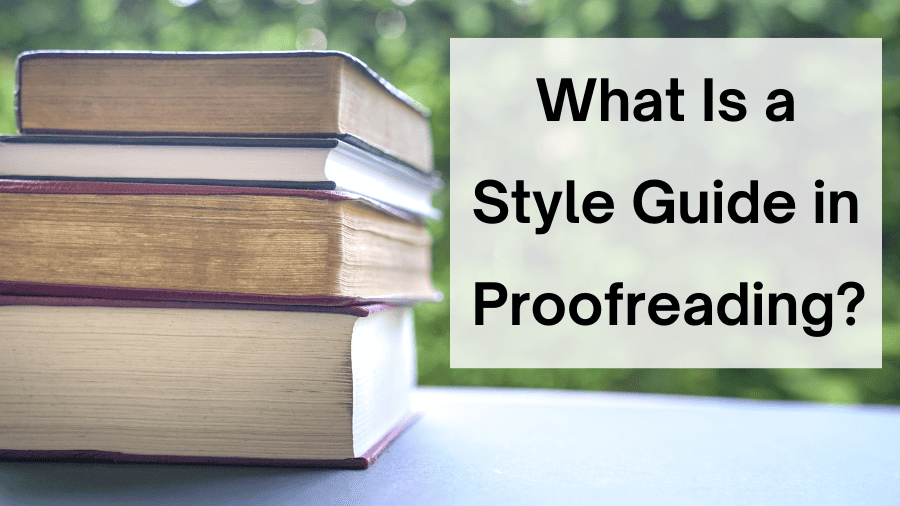This article may contain affiliate links. Please see our affiliate disclaimer in the footer menu for more information. Thank you for your support!

You may be aware that proofreaders use style guides. But what exactly is a style guide, and how do you use one? As someone who works in proofreading, I can help you answer this question.
A style guide is a compilation of guidelines for written content of a specific genre or dialect. It serves as a reference to ensure consistency, coherence, and clarity across a body of writing that shares a commonality.
Let’s discover more about style guides, including why proofreaders use them and which ones they use the most. I’ll also share my strategy for navigating guides quickly!
What Is a Style Guide in Proofreading?
Put succinctly, a style guide is a book of rules for writing of the same ilk.
“Generally style manuals include everything a writer needs to know in order to make their work look and read just like every other work written in that style — the look of the page, the way other authors are referenced in the body of the work, and even the tone of the writing.”
– Purdue Online Writing Lab
A style guide contains standards for numerous elements in writing, including the following:
- grammar
- capitalization
- punctuation
- spelling
- formatting (including info about how to cite sources and create a bibliography or reference list)
- word usage
- treatment of numbers and abbreviations
Style guides also provide general information about topics relevant to the particular kind of writing they cater to.
For example, the MLA (Modern Language Association) Handbook is frequently used for scholarly writing; therefore, it contains guidelines for paraphrasing, quoting, and avoiding plagiarism.
The Chicago Manual of Style is used for book publishing, so it contains a comprehensive section about the publishing process.
Which Style Guides Do Proofreaders Use the Most?

Here’s a long list of style guides if you’d like to see numerous examples.
However, I’m going to list four major style guides that are commonly used in the proofreading industry for content written in US English:
- The Chicago Manual of Style (Chicago Style)
- Publication Manual of the American Psychological Association (APA style)
- MLA (Modern Language Association) Handbook (MLA style)
- The Associated Press Stylebook (AP style)
The first three guides (listed above) are academic style guides, while the last one is journalistic.
For proofreading UK English, New Hart’s Rules: The Oxford Style Guide is popular.
Let’s discover the publisher and principal use for a few of the guides we routinely use to proofread US English.
The Publisher and Primary Use for Four Major US Style Guides
| Style Guide | Publisher | Primary Use |
|---|---|---|
| The Chicago Manual of Style | University of Chicago Press | book publishing |
| Publication Manual of the American Psychological Association | American Psychological Association | social sciences |
| MLA Handbook | Modern Language Association of America | the humanities |
| The Associated Press Stylebook | Associated Press | journalism |
Now let’s see when these guides were first published and their latest edition.
Initial Publishing Date and Current Edition of Four Major US Style Guides
| Style Guide | First Published | Current Edition* |
|---|---|---|
| The Chicago Manual of Style | 1906 | 18th |
| Publication Manual of the American Psychological Association | 1952 | 7th |
| MLA Handbook | 1985 | 9th |
| The Associated Press Stylebook | 1977 | 57th |
Why Do Proofreaders Use Style Guides?
Proofreaders employ style guides to ensure the content they’re working on suits the target audience by adhering to industry standards.
These standards are in place to maintain consistency, clarity, and professionalism in individual documents and across an entire body of similar works.
As mentioned, the style guide used for proofreading depends on the content’s genre.
If it weren’t for style guides, how would proofreaders know how to correct a piece of writing?
Case in Point: The Oxford Comma
For example, some style guides recommend using the Oxford (aka serial) comma, and some don’t.
We place the Oxford comma after the penultimate item in a series of three or more items.

Sentence with Oxford comma: She loves lakes, rivers, and streams.
Sentence without Oxford comma: She loves lakes, rivers and streams.
As a proofreader, you wouldn’t know whether the writer should use the Oxford comma if you weren’t following a style guide.
The three academic style guides in the tables above use the serial comma. But the journalistic style guide—The Associated Press Stylebook—only uses the serial comma when needed for clarity.
Remembering the rules for punctuation across the four major style guides I’ve listed can be challenging.
If you need help keeping track of the differences, I highly recommend a book by June Casagrande called The Best Punctuation Book, Period.
When I first started proofreading, I referred to it constantly. It saved me tons of time!
I talk about this book and a few others in my post about proofreading books.
How Do I Use a Style Guide Efficiently?

Before we discuss how to utilize a style guide efficiently, it’s important to note that some clients specify which guide they want you to follow, while others may provide a proofreading style sheet for you to adhere to.
A style sheet is like a mini style guide—usually one to a few pages long—detailing the writer’s preferences for specific elements like spelling, hyphenation, and the treatment of numbers.
After determining which guide is appropriate for the content you’re working on, you’ll need to decide whether to use the online version (if available) or a hard copy.
I use The Chicago Manual of Style (aka CMOS) for most of my proofreading work. It’s the guide I learned to navigate in the proofreading course I took.
I also follow it to create the content on this website.
Style Guides: A Hard Copy vs. the Online Version
Since CMOS is one of the most commonly used guides for proofreading, I’ll use it as an example throughout the rest of this article. However, you can apply the info that follows to any style guide.
CMOS is available online and as a hard copy.
I prefer the hard copy because I like something tangible.
Also, although you can create your own notes in CMOS Online, I prefer to take notes by hand in a printed copy. I find writing notes (as opposed to typing them) helps me remember them better.
Among the notes I take are definitions of grammatical terms, helpful acronyms, explanations of grammar and punctuation rules, and example sentences that follow certain rules.
Top-Notch Tip: CMOS is a big book; it could double as a doorstop or paperweight. If you travel often and use CMOS in your proofreading work, you’ll probably want to purchase an online subscription.
Sticky Tabs Are Super for Organization
Of course, I refer to the table of contents and index to help me navigate CMOS.
CMOS is divided into three parts. Proofreaders primarily use the second part, which pertains to style and usage.
To help me quickly find the info I need, I put little sticky flags at the beginning of frequently referenced chapters and sections.
Since the tabs are small, I use a symbol instead of a word to show what a section or chapter is about.
For example, I regularly refer to the comma section, so I’ve drawn a comma on that sticky tab.
I use these tabs similarly in other reference books to save time.
I also dog-ear pages within sections that I refer to repeatedly.
I penned a post about more time-saving proofreading strategies if you’d like more productivity tips.
I hope this article has given you a clear understanding of what style guides proofreaders use and how they use them.
Best wishes to you!
“You are never alone. You are eternally connected with everyone.”
– Amit Ray

Recent Posts
Punctuation is important because it enables us to communicate our message clearly and effectively. Without punctuation, we wouldn’t understand how units of a sentence relate to one another or how...
Although you're probably somewhat familiar with adverbs, you may be unaware of sentence adverbs. As a trained proofreader who has studied the parts of speech, I can help you understand this unique...
